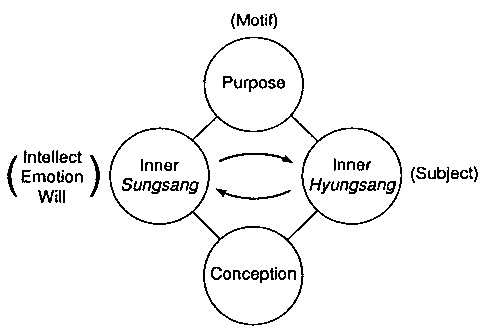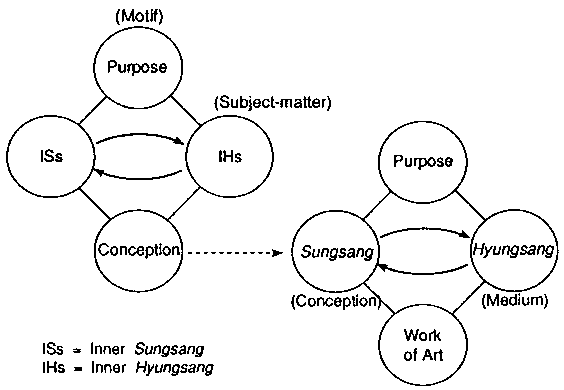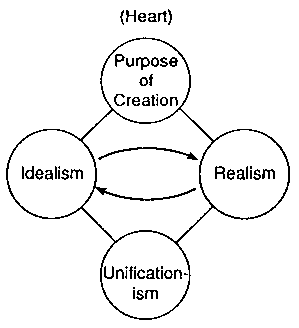
Essentials Of Unification Thought - The Head-Wing Thought

|
|
Essentials Of Unification Thought - The Head-Wing Thought |
|
IV. Requisites for Creation
In creation, there are requisites for the subject (artist) and requisites for the object (work of art). Also, techniques, materials, and styles of creation are important requisites in creation. Each of these points will be discussed in this section.
A. Requisites for the Subject in Creation
1. Motif, Theme, Conception
In creating a work of art, first there is a motivation for creation, or a motif, and based on that motif, a purpose for creating a specific work is established. Next, the theme, and then the conception, are established. The theme is the central content to be developed in the work, and the conception is a plan for the content and form of the art work that is to be created under the theme.
For example, suppose a painter, upon seeing an autumn landscape, is moved by its beauty and decides to paint it. The emotion aroused becomes the motif, and the purpose to create a painting of an autumn scene is established. Next, if, for instance, there are especially strong feelings evoked by maple trees, the artist may decide to express the motif centering on maple trees, and a theme such as "Maple Trees in Autumn" may be chosen. Once the theme is chosen, the artist forms a concrete conception of how mountains, trees, rivers, sky, clouds, etc. will be arranged, what colors will be used, and so on.
The creation of the universe by God can be described in a similar way. First of all, there was a motif, which was the emotional impulse to be joyful through love," namely, God's Heart. Next, God established die purpose of creation, that is, the purpose of creating an object of love resembling Him. Based on that purpose, the theme of human beings, "Adam and Eve," was determined. Then, a concrete conception of human beings and all things, namely, Logos, was established. That is how we can explain the creation of the universe by God.
In God's creative act, His Inner Sung-sang (intellect, emotion, and will) and Inner Hyungsang (ideas, concepts, and laws) engaged in give-and-receive action, within God's Sungsang, centering on Heart (Purpose), and the conception (Logos) was formed. The formation of this four-position base can be applied directly to artistic activity. To explain, the artist creates the conception by applying his or her intellect, emotion, and will in the direction of actualizing the theme. In other words, the artist creates the conception through a give-and-receive action between the inner Sungsang and the inner Hyungsang, centering on the purpose to create an art work. That can be understood as the formation of the inner four-position base in artistic activity (Fig. 7-1).

Fig. 7-1: Formation of the Inner Four-Position Base in Artistic Activity
Let us consider the example of The Thinker, by Auguste Rodin (1841-1917), which is a statue of a poet sitting in the center of the tipper level of the Gale of Hell, and was conceptualized on the basis of the first part of "Hell" of Dante's Divine Comedy. The statue portrays a poet engaged in meditation while watching the people in hell, who are groaning in fear, anxiety, and pain. Rodin's motif in creating The Thinker must have been the impulse to find the truth about human life. The theme was none other than The Thinker, and the conception was the design for expressing a man sitting and engaged in meditation.
Rodin's statue The Thinker and the statue of the thinking Maitreya-Bodhisattva from the Shilla dynasty in Korea, are quite different works of art, even though both have the same theme, a namely, a man engaged in thinking. The latter has as its motif the heart of the people waiting for the Maitreya, who was said to have been the most excellent disciple of Buddha and is to come again in order to save all humankind. As regards expression of Inner Sungsang, Rodin's statue displays a strong intellectual aspect, whereas the statue of Maitreya is centered on purified emotions, and, as a result, has become a very noble and holy statue.
2. Object Consciousness
Creation is an activity whereby an artist, in the position of object, gives joy to the subject, namely, God and the whole (humankind, the nation, tribe, etc.), by manifesting the value of beauty. For that, the artist must establish a sense of object consciousness. The attitude of wanting to give joy to God, the highest Subject, and to manifest the glory of God, is the culmination of object consciousness. The content of object consciousness will be discussed next.
First, the artist should seek to comfort God, who has been grieving with sorrow throughout human history. God created human beings and the universe to obtain joy, and even endowed humans with creativity. Therefore, the original purpose of human life is, above all, to give joy to God. Accordingly, people's creative activity should have been carried out, first of all, as a means to please God. However, people separated themselves from God and lost the consciousness of wanting to give joy to God. That has been the sorrow of God, even until today. Therefore, the artist should, above all, comfort God for His historical sorrow.
Second, the artist should have the attitude of wanting to comfort the many sages and righteous people, especially Jesus, who walked the path of restoration with God. To comfort them is to comfort God, who shared pain and sorrow with them.
Third, the artist should have the attitude of wanting to express the deeds of the good and righteous people of the past and present. That is, the artist should have the attitude of cooperating with God's providence by portraying the deeds of those people who were, and those who still are, persecuted by the sinful world.
Fourth, the artist should herald the coming of the ideal world, Therefore, the artist should create works expressing hope for, and confidence about the future. Through such works, God's glory is manifested.
Fifth, the artist should have the attitude of wanting to praise God, the Creator, by expressing the beauty and mystery of nature. God created nature for humankind's joy. Due to the Human Fall, however, people came to obtain little joy from the beauty of nature. Therefore, while having a feeling of awe toward nature, which is the manifestation of God's attributes, the artist should discover the beauty of nature, praise God and give joy to others.
Artists who have object consciousness and dedicate all their energy in their creative work, can receive blessings from God and assistance from the spirit world. That is how true works of art are produced. Such works. may be considered the fruit of co-creative work between God and the artist.
Among the artists of' the Renaissance, there were many who created their works of art with object consciousness. For example, Leonardo da Vinci (1432-1519), Raphael (1483-1520) and Michelangelo (1475-1564) were such artists. Beethoven (1770-1827), who perfected classical music, composed music with object consciousness. 12 That is why the works of those artists have become immortal masterpieces.
3. Individuality
Each person is a being with individuality, created in the resemblance to one of the Individual Images in God. Accordingly, in artistic creation, the artist's individuality is expressed as art work.
The reason is that artistic creation is an expression of the artist's individuality, which is an individual image of divine origin. The artist gives joy to God and to others by manifesting individuality. Individuality is fully manifested in great masterpieces. That is why the artist's name is usually attached to the work of art (e.g., Beethoven's Sixth Symphony and Schubert's "Unfinished" Symphony).
B. Requisites for the Object in Creation
The work of art must reflect the artist's Sungsang conditions, such as motif (purpose), the theme, and conception (plan). For that purpose, the artist must use materials that are most appropriate to manifest those Sungsang conditions. Moreover, the physical elements (components) should be arranged in a way that expresses complete harmony. Those are the Hyungsang conditions.
The harmony of the physical elements refers to rhythm of lines, harmony of shapes, harmony of spaces, harmony of light and dark, harmony of colors, harmony of tones, harmony of masses in painting, harmony of movement in dancing, harmony of segments in a line segment, and so on.
As for the harmony of segments in a line, there is the so-called golden section, which has been known since ancient times. The golden section is reached by cutting a line in such a way that the ratio of the shorter segment to the longer segment is equal to the ratio of the longer segment to the total length of the line. This is achieved by dividing the total segment in proportions of approximately 5 to 8. When this proportion is employed, the end result is felt as stable in shape and beautiful. For example, it is said that, if the relationship between the space above and the space below the horizon in a painting is made according to this proportion, harmony can be obtained. This golden section is said to be found in pyramids and in Gothic cathedrals.
C. Technique and Materials
The Two-stage Structure in the Original Image refers to the two-stage structure in which, first, the Inner Sungsang and Inner Hyungsang engage in give-and-receive action, centering on purpose, to form Logos, and next, the Logos and Hyungsang engage in give-and-receive action, centering on purpose, to form a created being.
All human creative activities are performed through this process. For example, activities such as manufacturing, farming, scholarly research, and industrial research, are performed according to this two-stage structure of creation.
This holds true in the creation of artistic works. As for the formation of the inner four-position base, I have already explained it in terms of requisites for the subject. To repeat, centering on the motif (purpose), the Inner Sungsang (intellect, emotion, and will) and Inner Hyungsang (theme) engage in give-and-receive action and produce a conception. That is the formation of the inner four-position base. Next, an outer four-position base is formed through give-and-receive action, centering on the motif (purpose), between the Sungsang (conception) and the Hyungsang (materials). In the formation of the outer four-position base, special techniques or abilities may be required. This is called the technique of creation.
The materials required to create a work of art consist of Sungsang materials (i.e., the object of the expression) and Hyungsang materials (i.e., the means of expression). The Sungsang materials are called the "subject-matter." In writing, the events, actions, and objects described are the subject-matter. In painting, the people, landscape, and other images are the subject-matter. The subject-matter is the same as the theme in the formation of the inner four-position base in artistic creation.
The Hyungsang materials (i.e., physical materials) are called the ,.medium." In a sculpture, such materials as chisels, marble, wood, and bronze are necessary. In painting, paints, canvasses, and so on are necessary. In producing a work, the artist determines the quality and quantity of these physical materials and uses them in concrete creation.
In this way, first the artist produces a conception, and then completes the work by using specific materials. This process is called the two-stage structure of creation," which is illustrated in Fig. 7-2.
1. Styles and Schools of Artistic Creation
Style of creation refers to the method of artistic expression, which is the particular way the two-stage structure of creation is formed. Of importance here is the manner in which the inner four-position base is formed, or the style of conception. The inner four

Fig. 7-2: The Two-Stage Structure of Artistic Creation
position base is formed through the give-and-receive action between the inner Sungsang (intellect, emotion, and will) and inner Hyungsang (theme), centering on the motif (purpose). Therefore, when there are differences in the motif, there will be differences in the finished works as well. With the same motif and with differences in the inner Sungsang, works will differ as well. Also, with differences in inner Hyungsang, works will likewise differ. With differences in any of these three elements, the conceptions will differ, and the works, also, will differ. This is the origin of the various styles of creation. Based on these various styles, different schools of art have appeared. Below, a few of the schools of art in the West will be briefly described.
a) Idealism
Idealism is a style that seeks to express ideal beauty by idealizing human beings and the world. Many of the 16th century Renaissance artists were idealists. Raphael is a representative painter of this school.
b) Classicism
Classicism refers to the artistic tendency in the 17th and 18th centuries to follow the examples of the forms of expression of Greco-Roman art. It attached importance primarily to form, seeking to achieve unity and balance. A representative literary work is Raust by Johann W. von Goethe (1749-1832). Among the painters, we can mention Jacques L. David (1748-1825) and Jean AD Ingres (1780-1867).
c) Romanticism
As a reaction to classicism's focus on form, romanticism (18th and 19th centuries) sought to give expression to passions. Among romanticists, we can mention the writer Victor Hugo (1802-1885), the poet Lord Byron (1788-1824), and the painter Eugene Delacroix (1798-1863).
d) Realism/Naturalism
Realism is a tendency to depict reality as it is. This style emerged as a reaction to romanticism, during the period from mid to late 19th century. Representatives of this school are the painters Jean B. C. Corot (1796-1875), Jean F. Millet (1814-1875), and Gustave Courbet (1819-1877), and the writer Gustave Flaubert (18211880). The style of realism developed a tendency toward positivism and scientism which led it to naturalism. A representative writer of the school of naturalism is Emile Zola (1841-1920). In the area of fine arts, there was no distinction between realism and naturalism.
e) Symbolism
Symbolism arose from the late 19th Century to early 20th Century as a reaction to real ism/naturalism. As a school of literature, it sought to express feelings with symbols, abandoning the traditions and forms of the past. A representative of this school is the poet Arthur Rimbaud (1854-1891)
f) Impressionism
The school of impressionism considered the image caught at one instant to be the true image of things, and sought to express momentary impressions of shapes and colors. This movement developed centering on France in the late 19th Century. Edouard Manet (1832-1883) and Claude Monet (1834-1917) are representative painters of this school.
g) Expressionism
Contrary to impressionism, which depicted impressions coming born the outside, expressionism sought to express the internal side. It arose as a reaction to impressionism in the early 20th Century. The painters Vasily Kandinsky (1866-1944) and Franz Marc (18801916) and the writer Franz Werfel (1890-1945) are representative artists of this school.
h) Cubism
Cubism, a fine-art movement of the early 20th Century, sought mentally to disassemble objects into simple shapes and then recompose them according to the artist's subjectivity. The representative painter of this school is Pablo Picasso (1881-1973).
i) Unificationism
The artistic style of the Unification Theory of Art is Unificationism, in which idealism and realism are united, centering on the Purpose of Creation. (Fig. 7-3)

Fig. 7-3: The Artistic Style of Unificationism
Since Unificationism aims to realize the kingdom of heaven on earth, it must regard reality as important. Accordingly, Unificationism becomes realism. At the same time, however, it has the ideal of returning to the original world, while living in reality. So, the style is idealism as well. Therefore, the unification of reality and ideal becomes the Principled attitude of creation. For example, Unificationism. would depict the image of the human being filled with hope, seeking to overcome hardships in the actual sinful world, while longing for the original ideal world. Unificationism is Heartism, that is, a theory centered on God's Heart. Thus, Unificationism expresses ideal love centered on God, which naturally contains romantic elements as well. However, it is not romanticism as in the past. When dealing with love between man and woman, it will depict the ideal and realistic love between man and woman centered on God's love.
The various styles and schools of art mentioned above can be divided, in a broad sense, into realism and idealism, whereby realism is understood not in the sense of "a style that depicts reality as it is," but in the sense of "a style that is considered currently fashionable in a specific period," and idealism is understood not in the sense of "a style that depicts ideal human beings and ideal reality," but in the sense of "a style that attempts to give rise to something new, and is oriented toward the future, in opposition to what is currently fashionable in a specific period."
In this sense, each of the past styles started out as "idealism," but later became "realism." Then, it can be said that Unificationism as a style of art is the "unity of realism and idealism" in this sense as well.
In Unificationism, which is a style patterned after God's creative act centered on Heart and the purpose of creation, the basic style is unchangeable and eternal, even though there may be stylistic differences based on individualities.
Download entire page and pages related to it in ZIP format
Table of Contents
Information
Tparents Home